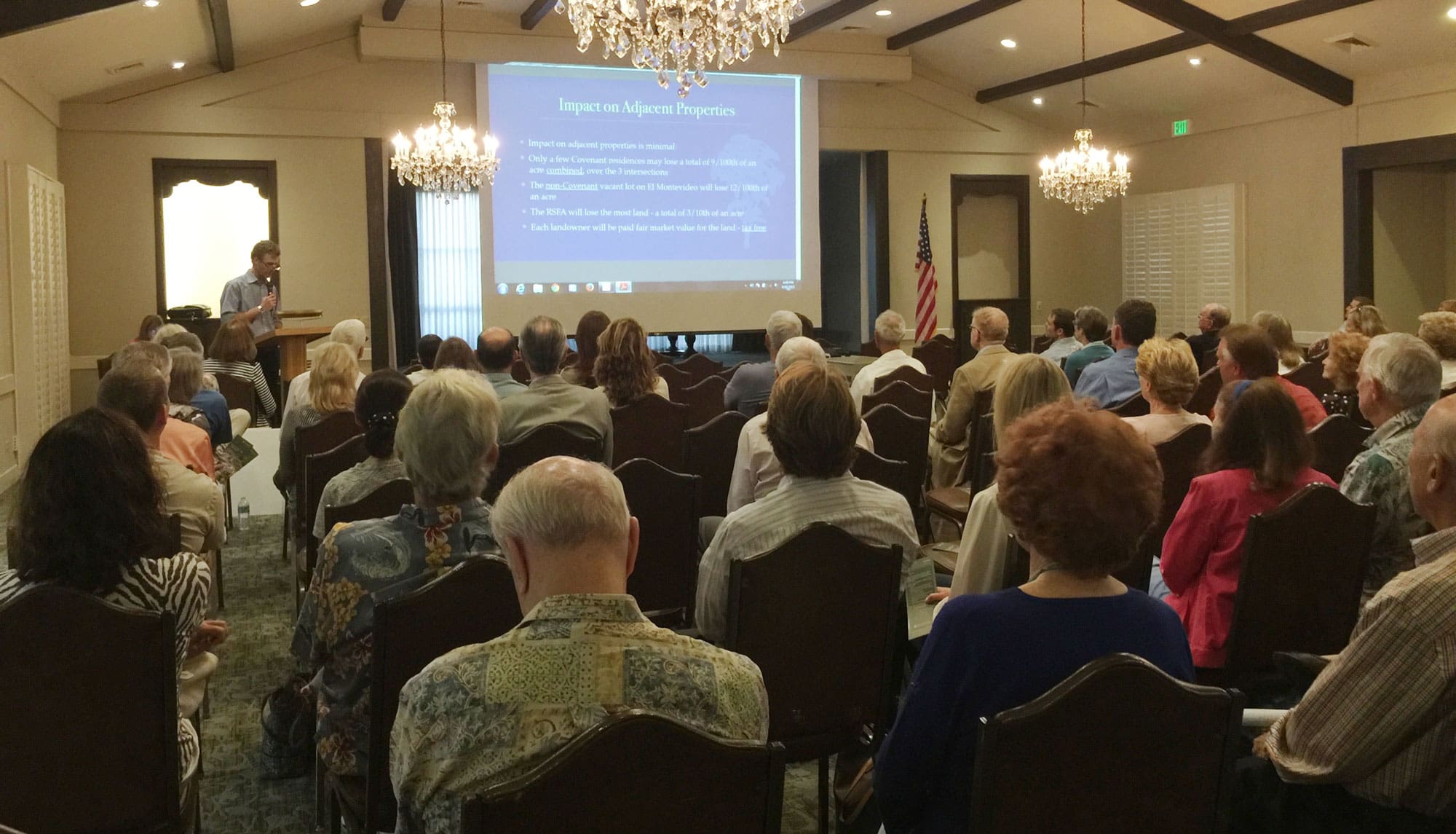From the MyRSF.net archives of the RSF Post
Town Hall on Intersections Draws Big Crowd Ahead of Community Survey
Author: RSF Post
Date: September 18, 2015
Residents of Rancho Santa Fe had a final opportunity to hear arguments from each side of the roundabout v. traffic signals debate on September 16, 2015. Over 100 residents attended the meeting, which was held at the Rancho Santa Fe Garden Club.
The groups in support of roundabouts as well as signals were given a final opportunity to make their respective cases before a community survey is mailed out this week.

One survey will be mailed to each property owned by a dues-paying member in good standing, which includes those who may not be registered to vote. Completed surveys are due back to the Association by October 30.
During the meeting, each side was allotted 15 minutes for their presentations and granted a 3-minute rebuttal period. The roundabouts group won the coin toss and presented their case first.
Association Manager, Bill Overton, commenced the meeting explaining, "Each side believes to their core… that their point of view is in the best interest of this community."
Overton's official capacity at the meeting was to act as a semi-moderator and keep time constraints fair. He also answered direct questions from community members who were concerned with how the survey is being conducted.
"[The Association isn’t] sending out a half-baked product," said Overton.
He elaborated, saying that fraud will not be an issue in this survey because significant precautions have been taken, including tax identification numbers to ensure there would be no double voting.
After passionate arguments from each side, the floor was opened up for public comment.
Nearly a dozen public comments were delivered, primarily in support of one of three positions: to install traffic signals, to construct roundabouts, and to leave the roads as they are. By the end of the meeting and after hearing both presentations, residents still appeared split on what road to take.
Patricia Simmons, who has been involved in this debate for 13 years, said she "still doesn't know the truth." She implored the community to take a third route and figure out something besides roundabouts or traffic signals.
As a self-proposed roundabout fanatic, Phil Kirk, joked there "must be an enormous traffic light lobby" in America because no other country has as many. On a more serious note, he explained his desire for the RSF community to remain unique and install roundabouts rather than traffic signals.
Wei Zhang concluded the public comment portion of the town hall, arguing that the data needs to be scientific and that the community cannot make a decision without properly vetted data.
Roundabouts
View the Pro-Roundabouts Slide Show
Rich Carlson, Laura and Kent LeMarié, Bill Siino, and Glen Griffin spoke in favor of constructing roundabouts.
Carlson, a 27-year RSF resident, said "roundabouts are the future of American roads. They are the first choice of CalTrans and San Diego County."
Roundabouts are more efficient and aesthetically pleasing compared to traffic lights, he continued. "The Rancho Santa Fe Covenant is successful because it maintains a rural character and traffic lights will hurt property values."
Laura LeMarié eased people's fears of the unknown and assured residents that people drive slower with roundabouts. There won't be any stop-and-go traffic like there would be with signals, she said.
LeMarié handed the baton off to Bill Siino, CEO of Systems Simulations, who explained that roundabouts work perfectly in Santa Barbara, which happens to have a higher flow of traffic compared to Rancho Santa Fe.
Since drivers are inclined to slow down in roundabouts, there are fewer injuries and accidents, Kent LeMarié said.
"Roundabouts eliminate the kill zone and rear end collisions. There are 56 points of possible collision in traffic signals and only 16 in a roundabout," he explained.
Wrapping up the roundabout presentation, Glen Griffin concluded that “roundabouts are cheaper in the long run, better for the environment, and receive federal funding.”
Signals
View the Pro-Signals Slide Show
Sam Ursini spoke on behalf of constructing traffic signals. With 15,000 cars driving through the ranch every day, he argued that there needs to be a simple and successful solution with safety as the main concern.
"Traffic lights are simple," he said, adding that they "take four bolts in a concrete pad and do not infringe on any private property."
Roundabouts will take 18 months of construction which the RSF side streets cannot handle, he explained. Signals won't require detours.
A significant portion of Ursini's presentation focused on the differences between the two studies being sent out to residents. Ursini explained that KAI, the group used by roundabout proponents, "was not vetted and was not reviewed by the county."
"Our studies show by our analysis that roundabouts won't work and our data proves they fail. We have documentation from the county engineer manager that refuted much of the roundabout information," he continued.
A continuous flow isn't good for traffic or safe for pedestrians, Ursini said.
"Electronics are changeable and lights are more accommodating for traffic because there are green and red lights," while roundabouts only have "flashing amber lights," he added, insinuating that stopping is not mandatory.
"Environmentally, signals are a far superior solution," Ursini concluded.
The County of San Diego holds ultimate authority on whether or not there will be roundabouts or signals at the intersections of Via de la Valle, El Montevideo/La Valle Plateada and El Camino Del Norte.
Survey results in the past have gone both ways. In May, a majority of attendees at a town hall meeting supported traffic lights, while 63 percent of respondents supported roundabouts in an online survey conducted by the RSF Post.

 Chronicles
Chronicles